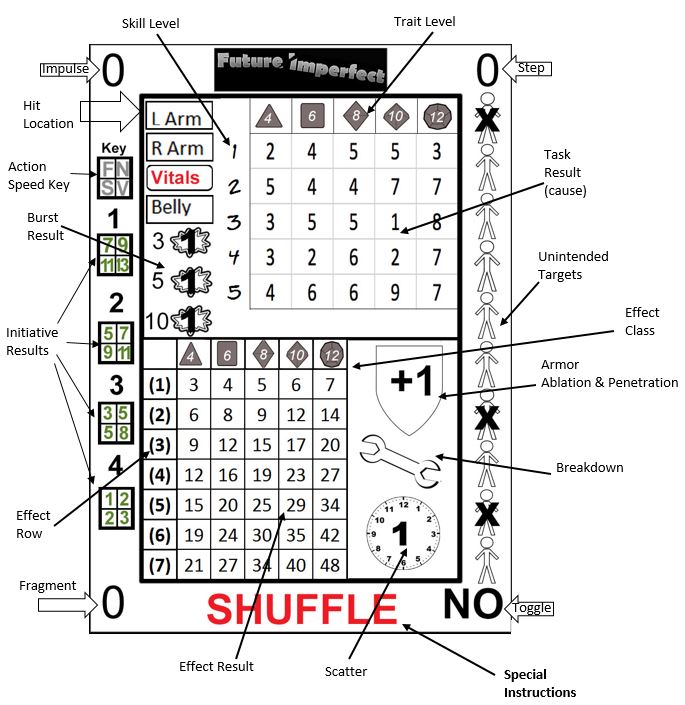Future Imperfect: Appendix - 1, Action Cards
The action cards contained in Future Imperfect look very different from cards used in other games. To many, their layout might not seem intuitive. Information is densely packed, yet it is also distributed consistently to make referencing them simple. Introductory instructions on their use can be found in Future Imperfect - Action Cards. This appendix covers the minute details of the layout, as well the how and why of the entries on the cards themselves.
Contents
Card Map
How do I know what the numbers mean? What is the difference between the two grids? Why is there a clock face? The definitions that follow map the entries and can be used as a reference when other rulebook sections refer to results.
The Four Corners
Every action card has a number in 3 corners, and either yes or no in the other. These entries can be used for various situations, but their meanings describe the origin of the action cards themselves. They are not part of standard task resolution. None of the corner results are randomly distributed.
Upper Left
In the upper left corner is a number from 0 to 53, referred to as impulse. The action card deck is 54 cards, based on a standard poker deck with jokers included. Each card has a "value" (more on this later), and that is what determines the number in this location. The higher the number, the higher the value. Numbers in this location are unique.
Upper Right
The number in the upper right is the first clue to how the value of a card is determined. These numbers range from 0-14 and represent the rank of the card, with the jokers being 0 and 14. The rank is in order based on poker rules, with the deuce being 1 (the lowest) and ace being 13 (the highest). There are four each of the 1-13, and one each of 0 and 14. These numbers are called steps.
Lower Left
The lower left represents the suit of the card, in magnitude order. Magnitude is determined alphabetically: clubs (1), diamonds (2), hearts (3), spades (4). The jokers are assigned magnitude based on color, with the red joker being zero, and the black being 5. These numbers are called fragments.
Lower right
The lower right result is a yes or no value representing color. If no, then red, if yes, then black. These results are toggle.
Origin
The value ranking for cards was initially developed as an initiative system. It still can be used as such, and it also works well for determining random timings (discussed in a later section). The names given to the corner results hint at the timing system that was originally developed. Eventually, the current initiative system evolved, and this usage was abandoned.
The unique number in the upper left provides a simple way to reference cards. Both the step and fragment are useful for non-homogeneous distributions that are mostly normalized but can also produce extraordinary results. These usages are detailed in various sections of the rules.
